Written by Sierra Downey. Photographed by Paige Green Photography.
When Gynna Clemes sits down to sew, she thinks about the many, many hands that have touched this garment in the making.
“When I am sewing and creating and in that process, I truly think about where the fiber came from. I think about the makers of it,” said Gynna, addressing an attentive audience of artists, educators, crafters, and learners on a cloudy September afternoon in Point Reyes Station, CA. “And then I think about these stitches and who the recipient is going to be…”
It is this journey of a garment, in its many iterations and interconnected relationships, that the Fibershed community gathered to celebrate at “Rooted in Simplicity” on September 17th. Held at the Fibershed Learning Center at Black Mountain Ranch, on land that was stewarded by Coast Miwok people for countless generations, the afternoon’s event was an invitation to appreciate the bounty of textile knowledge, experiences, and resources specific to this bioregion and the beings who call it home. The lines between producers, artisans, and consumers faded as connections to each other and to the land took center stage.

The walk down from the parking lot, winding under a leafy canopy and around ancient roots, invited guests to leave the complexities of daily life behind for an afternoon of rediscovery and recovery. Cloth displays illustrating carbon farming and Climate Beneficial™ fiber greeted community members at the entrance along with a welcoming taste of locally-crafted Heidrun Meadery mead. Following the reverberating thrum of percussive beats and lyrics of liberation from Audiopharmacy, guests entered into a marketplace, where many greetings and joyful exchanges were taking place. Vendors from all areas of the Northern California Fibershed community — growers, spinners, weavers, designers, knitters, crocheters, dyers, sewists, and toy-makers, set up their wares.
Fibershed Executive Director Rebecca Burgess opened the celebration by orienting us in the moment and space, reflecting on how much had changed since the last gathering in 2019.
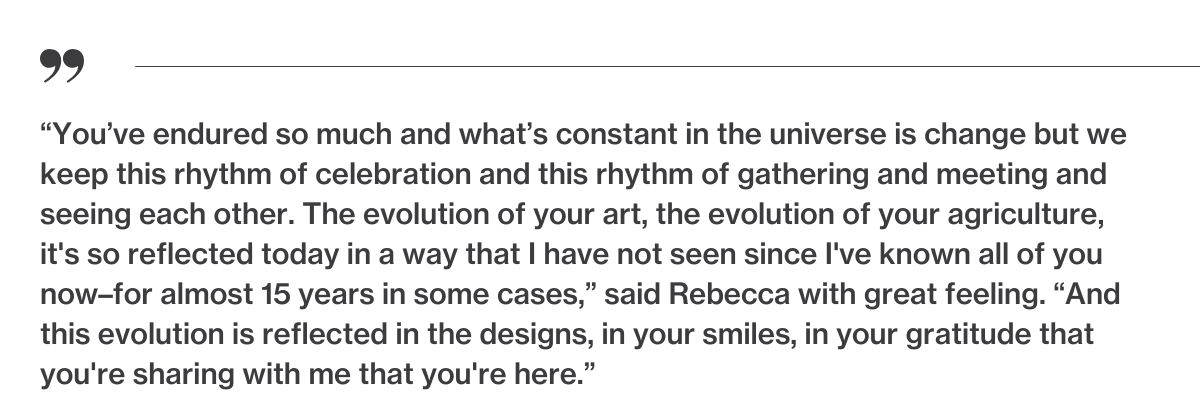
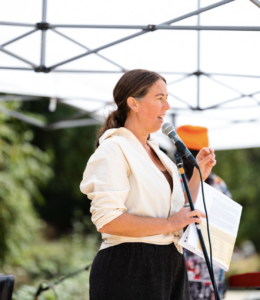
Many of those evolutions were present in the Fibershed Marketplace, where twenty-two vendors brought offerings of roving, yarn, natural fiber hand-crafted garments, toys, reclaimed textile goods, sustainably-crafted household products, natural dye materials, and more. For a number of those present, any delineation between “producer” and “artist” was unnecessary: These were friends who support each others’ vision and help nurture each other’s businesses.
“We have to sort of stick together because we have a shared vision and appreciation and love of fabric, cloth, sheep– the source material,” said Grace Johnson, a natural dye artist and educator in the Fibershed community who calls her practice Transmutation. “That generates a lot of interesting conversations and just a new, real understanding of the world.”
Throughout the afternoon community members meandered in the verdant space, attending workshops and demonstrations led by Fibershed educators and artists. Interwoven with five stations of a walkable, interactive Garment Use Lifecycle, each workshop invited participants to deepen their own connections to their clothes and to the lands and hands that created them.
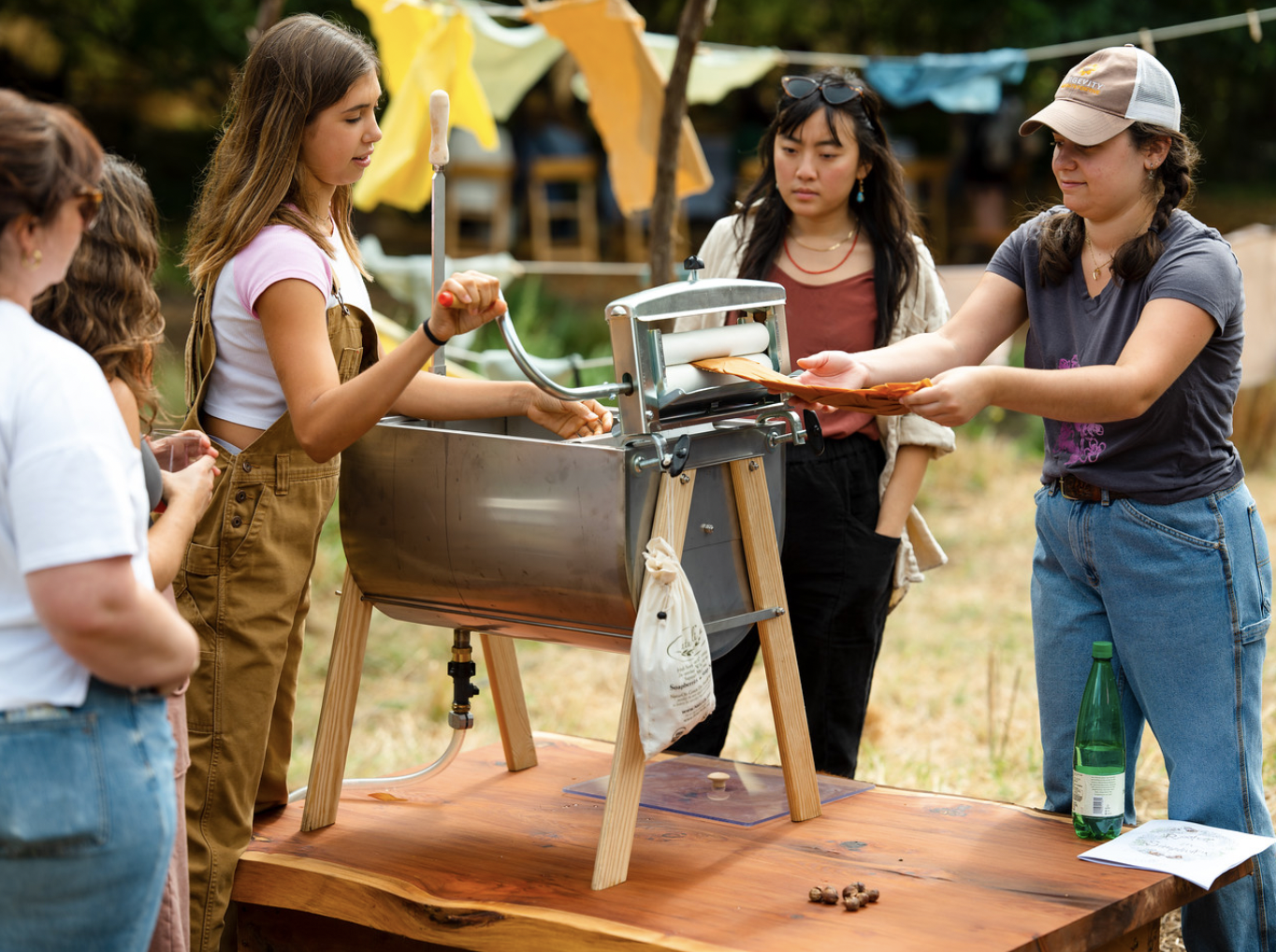
By the redwoods at the front entrance to the Learning Center, visual storyteller and installation artist Alison Smith of Wildcat West invited guests into a practice of using needle felting techniques to create mending patches. Inside the Learning Center, with a view overlooking the dye garden, learners practiced another form of mending with textile artist and Fibershed founding producer member Heidi Iverson of Honey Folk Clothing. We sat on pillows about a table covered in spools of colorful thread and naturally dyed cloth remnants. As we prepared our needles, Iverson illustrated her methods for assessing damaged areas and choosing cloth for patches.

Just outside the studio, Grace Johnson led a natural dye workshop where participants gained confidence in renewing old garments with fresh, natural color. We practiced on patches of cloth to use in mending, tying cottons, wools, and silks in interesting shapes and submerging them in small vats of coreopsis and weld dye. Johnson encouraged guests to look at would-be waste around them and challenge themselves to see the colors they could draw from it.
“Through the process of natural dyeing you learn so much about your earth and about your lands,” said Grace. “And I’ve learned so much about my own identity through that as well. It’s really just a spirit-led practice, and I’m connecting to my roots and heritage because that’s where my soul resides.”
This connection, a returning to knowledge and practices past, was tangible in each workshop. Nearby, guests returned to one of the oldest methods of creating cloth, weaving on backstrap looms with weaving teacher Travis Meinolf of Meinolf Weaving School. Under the embracing shade of a great willow tree, other learners sat with Charlie Kennard, longtime student and weaver of traditional basketry techniques from around the world, and settled into the practice of weaving a skep, or straw beehive. At a nearby patch of dogbane (a local native perennial that has been an important fiber plant across millennia of human history), Redbird Willie, a native Pomo, Wailaki, Winto, and Paiute teacher and ecologist invited us to learn about native plant fibers at home in the bioregion. This longtime artist and community-builder shared examples of his traditionally crafted work, and students practiced twisting their own length of dogbane twine.
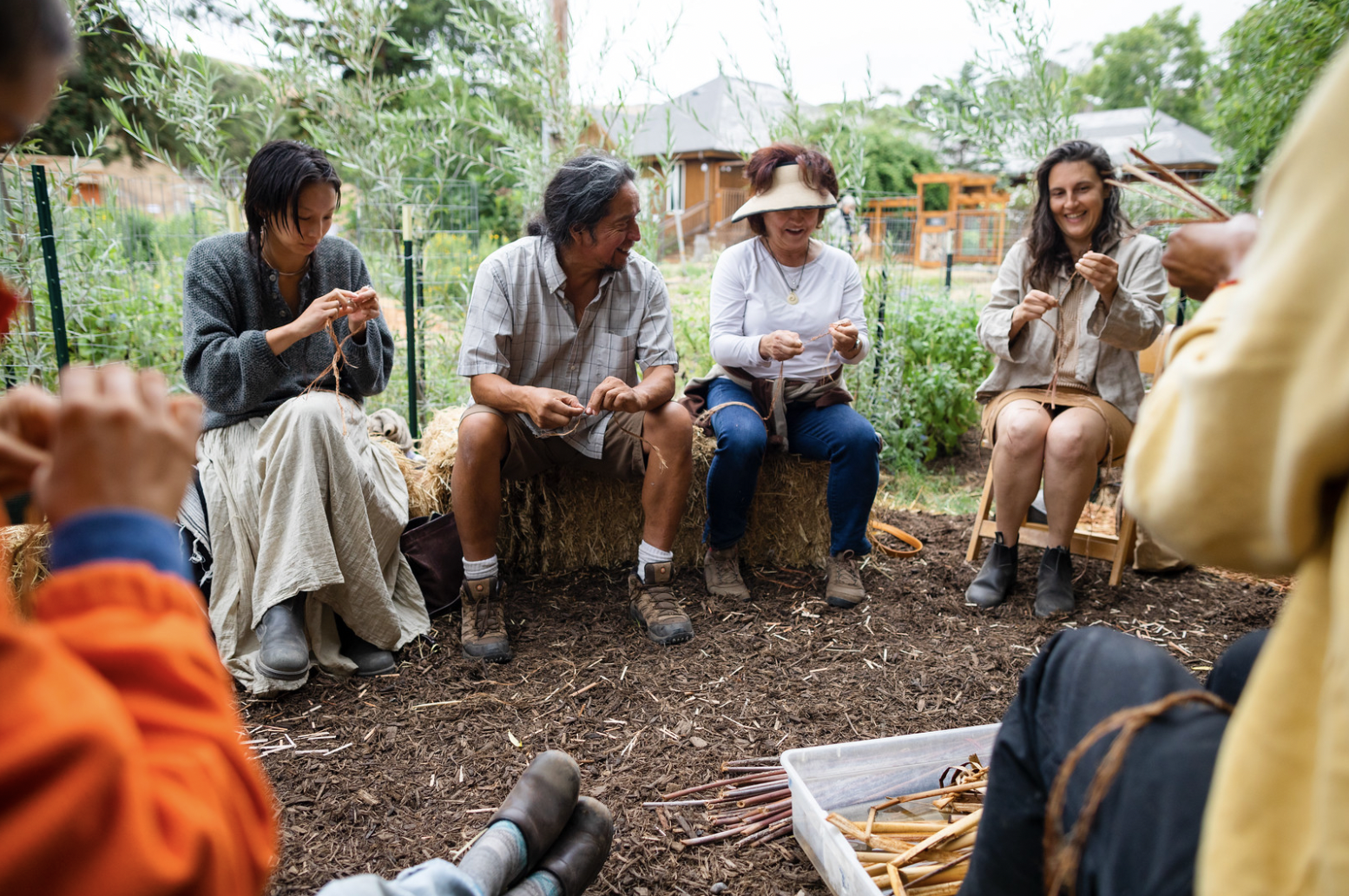
After deepening our knowledge in workshops on the creation and upkeep of clothes, there were just a few steps left in the garment life cycle.
A colorful clothesline filled with brilliant hues of naturally dyed cloth greeted us on one side of the Fibershed Learning Center Studio. Here we learned how to create bio-safe suds from soapnuts and to wring and air dry our garments to improve their longevity. Finally, the last station in the interactive Garment Life Cycle was textile composting. Here we reflected on the impact of putting carbon-based matter back into the ground, creating food for the soil that in turn feeds us and grows our wardrobes.
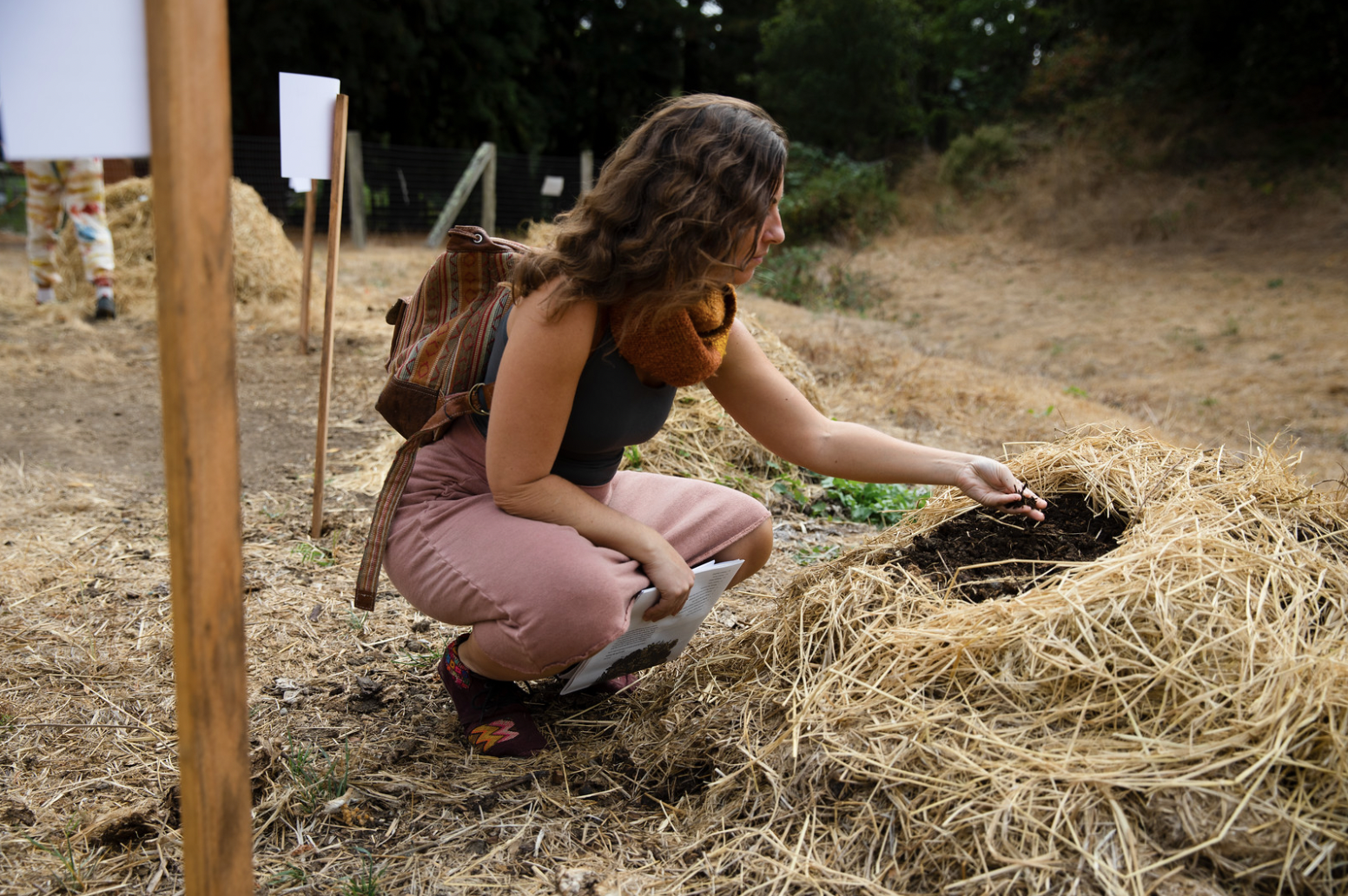
In the Fibershed Learning Center Studio was the Featured Artist Installation and the sacred work of Tiśina Ta-till-ium Parker, founder of arts-focused Indigenous activist organization Native One. As the granddaughter of Yosemite Southern Sierra Miwuk/Kucadikadii Mono Lake Paiute and Kashia Pomo peoples, Parker tells stories through her practice of craft, textiles, and regalia making. She roots much of this work in traditional ecological knowledge. Her installation represented the traditional and sacred regalia of women from Pomo, Paiute, and Sierra Miwuk of Yosemite tribal groups. The intentionally harvested materials–furs, hides, seeds, shells, feathers, plants–hold deep value and, in the process of being transformed into regalia, help define identity, place, and connection to ancestral land and the relatives (of all kinds) within it.
Another highlight of the event was the Student Designer Showcase, featuring garments constructed with a soil-to-soil mindset. Designed by fashion students at College of Alameda Apparel Design and Merchandising (ADAM) and the Santa Rosa Junior College (SRJC) Fashion Studies Program, their work displayed the interwoven relationships of local Fibershed producers to each other and to our bioregion.


For guests who had come from near and far to be in community, these exhibits, workshops, and invitations to deepen their relationship with the land planted many seeds. Yolanda Burrell, a community-based urban farmer in Oakland, reflected on what she would be taking back to share in her own practice. “It’s interesting to learn about kitchen waste from food plants and the variety of wild foraged plants that can be used for dye making,” said Yolanda. “As a farmer and textile enthusiast, I’m very interested in learning how to grow small batch dye plants to offer to the Fibershed community. I really value my natural fiber clothing and textiles, knowing that they can have less impact on the planet and can eventually be used as inputs for the next generation of textiles.”
Dark clouds bearing long-awaited rain rolled in towards the afternoon, as if to anoint the day’s spotlight event: the Designer Showcase. It was time to honor the work of 14 designers who crafted 51 different garments worn by 17 models drawn right from the community. With reverence we gathered on sheep hides and hay bales on the knoll by the historic barn, facing a great lichenous stone and a flower installation crafted by indigenous floral artist Marilú Rivera.
“Simplicity is where we find balance, find comfort, remember our origins,” said Gynna Clemes, welcoming us to the showcase. “As the world moves to progress forward, it’s easy to forget that sometimes progression is really a coming back to. A reminder of where we have come from, what gives us life: The air, the soil, the sun, the microbes, the elemental components of life in its most basic form.”
Over the next hour, the distinction between producer and artist, creator and consumer, dissipated as designers and models stood up from the midst of the audience to display their garments. It was an aesthetic and powerful reminder that in nurturing our local economies, we all fill the roles of consumers and producers for each other at different times. The imperative to understand local economy and ecology as parallel relationships felt tangible and indeed possible.
Fabric from Fibershed producers formed the foundations of most of the designs. Cloth made with Lani’s Lana Bare Ranch Wool, raised with Climate Beneficial™ land management practices, and woven by Huston Textile Co., featured in Kristin Morrison of All Species’ coat and trouser designs. Kristin echoed the interdependence of creation and community as she shared her design process with us: “I’m looking around. I’m connecting with my local farmers. I’m connecting with you all to really give voice to the land through the medium of garments.”

Italia Hannaway also employed the cloth in her designs for the Italia A Collection, creating a robe-like jacket, zero waste design pants, and a cropped patchwork jacket that featured the natural dyeing skills of Heather Podoll and dyes grown by Kristin at The Ecology Center. Jennie Lee Henderson used Lani’s Lana Community Supported Cloth to create a three-quarter length sleeve shirt that she designed free form (without making a pattern) and then naturally eco-printed. Elaine Hamblin of KOSA (arts), a sustainable design studio in Oakland, also used the Climate Beneficial™ wool to create a fringed dolman hoodie inspired by her design experience in the 80s.

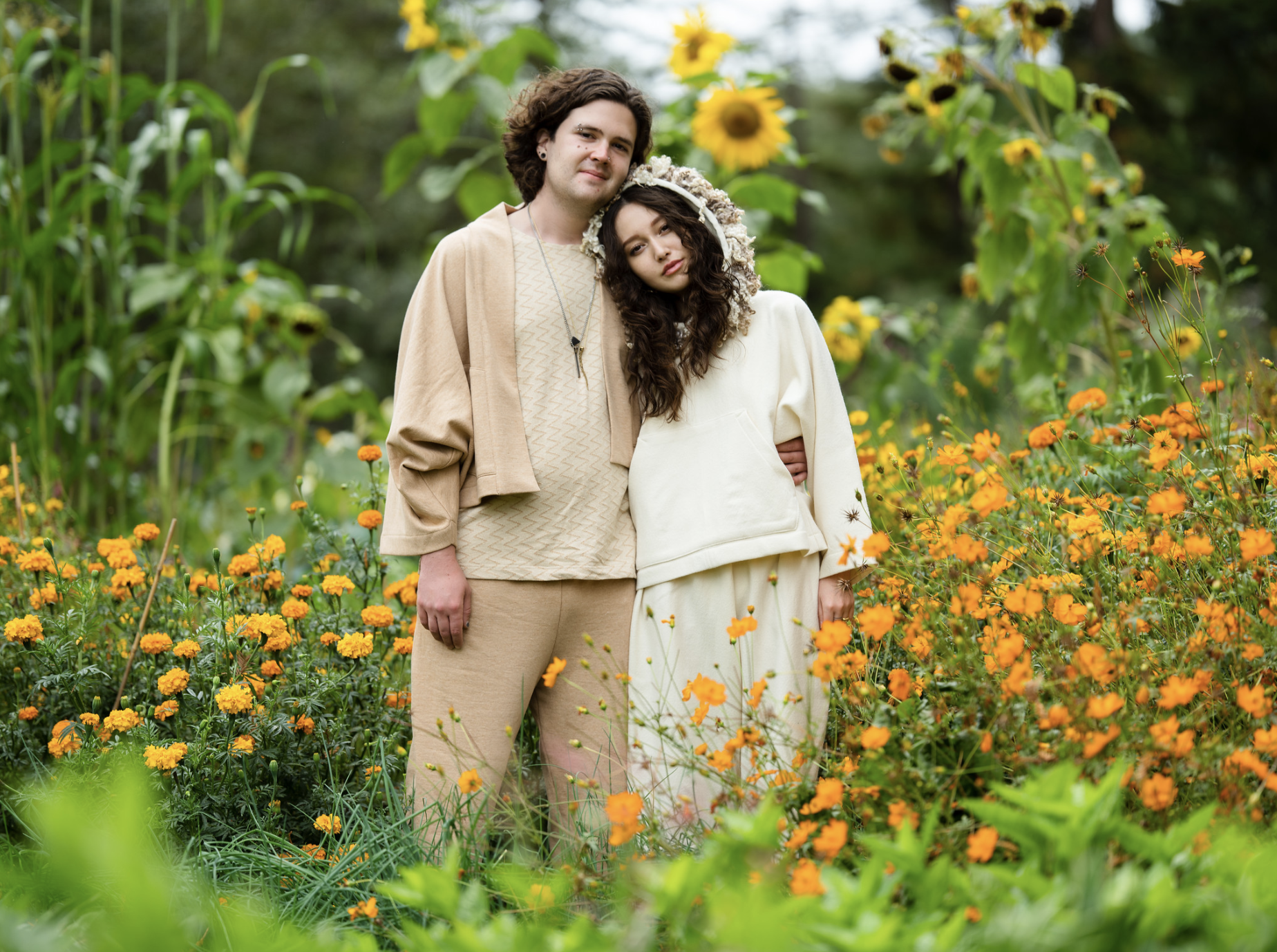
Elaine and Italia also collaborated on a day dress and sleeper made from Sally Fox’s Vreseis FOXFIBRE® COLORGANIC® cotton, a renowned naturally colored, locally-grown cotton.

For her cowl neck sweater, Gynna Clemes used a cozy blend of Climate Beneficial wool and California-grown organic cotton called Climate Beneficial Collaborative Cloth. A creative collaboration between Fibershed-certified producers Lani’s Lana and California Cloth Foundry, this knit fabric was an apt symbol of the interwoven relationships being celebrated that day.

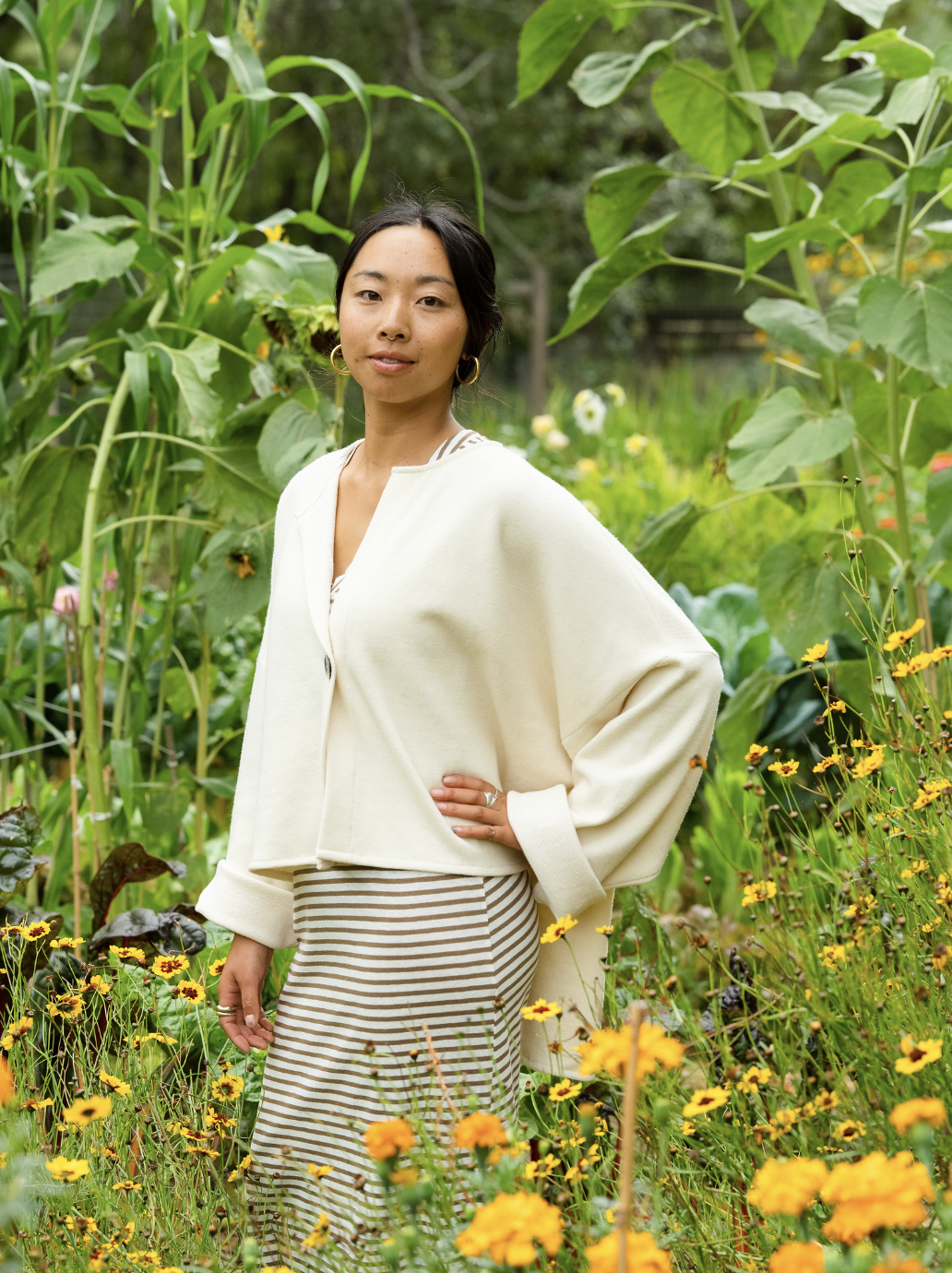
Still other designers showcased garments made with handspun and knitted wool.


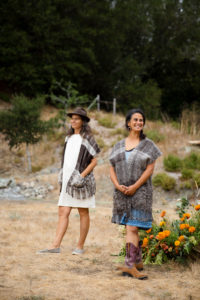
It is the simplicity of this creative moment that we kept returning to throughout the gathering. And in the combination of many different people’s creative moments, we build resilient relationships, a vision that Rebecca reflected on as she closed the day’s gathering.
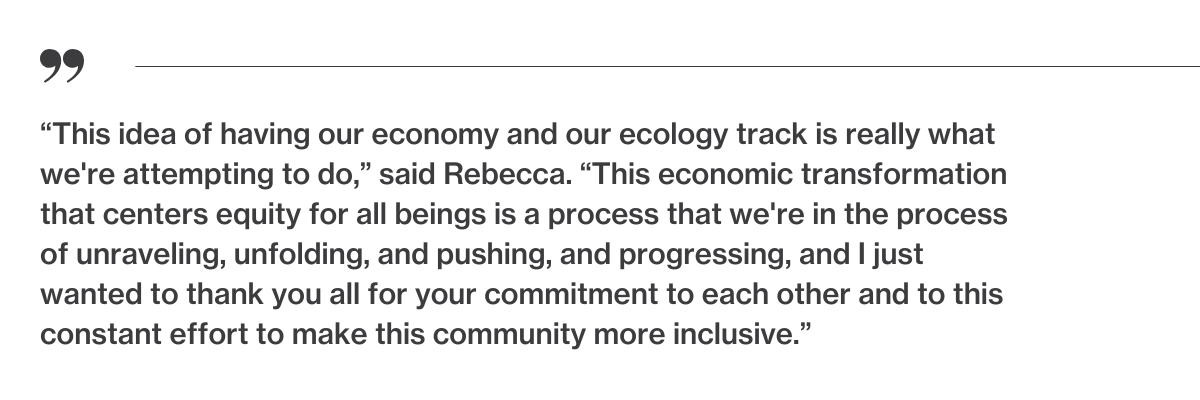
The day inspired thoughtful questions–how do we continue building the regional economic systems required to share our resources equitably and effectively? How do we sustainably reclaim our time? How can we spend more of it on the intentional care and creation of our clothes–and the relationships that underpin them? But Rooted in Simplicity demanded no answers. Planting those seeds–as we sat on local Shepherdess Holistic Hides’ sheep hides and bales of hay, underneath the warmth of Climate Beneficial™ Wool blankets, celebrating one another’s creativity–was enough.
Some items from the Rooted in Simplicity Designer Showcase are still for sale. View here for full designs and availability.
